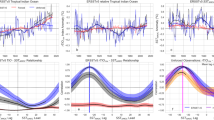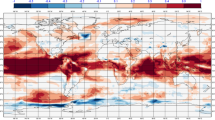Abstract
This study investigates how variations of the Atlantic meridional overturning circulation (AMOC) affect sea surface temperature (SST) within the simulations of the coupled model intercomparison project phase 5. In particular, we explore whether the SST response is interhemispheric in nature, specifically as reflected in the Atlantic SST Dipole index, or whether the response is localized more in the North Atlantic Ocean. In the absence of direct observational data, this Dipole index has been proposed to approximate AMOC variations over the duration of the instrumental temperature record. We find that typically, on timescales between decadal and centennial, the SST Dipole index correlates with the AMOC with coefficients ranging from 0.2 to 0.7, typically with a 0–6 year lag, and thus explains less than half of the AMOC variance. In just two models this value slightly exceeds 50 %. Even for the models with the highest correspondence between the AMOC and the Dipole index, the correlation between the two variables is controlled mainly by SST variations in the North Atlantic, not the South Atlantic, both for the model control and historical simulations. Consequently, in nearly all models, the North Atlantic SST provides a better indicator of AMOC variations than the Atlantic Dipole. Thus, on decadal to centennial timescales AMOC variability affects mainly the North Atlantic Ocean, with the sensitivity of the North Atlantic SST between 40 and 60°N, given by the multi-model average, of about 0.3 °C per 1 Sv of AMOC change, explaining roughly one third of the SST variance.







Similar content being viewed by others
References
Álvarez-Garcia F, Latif M, Biastoch A (2008) On multidecadal and quasi-decadal North Atlantic variability. J Clim 21:3433–3452
Ba J, Keenlysid N, Latif M, Park W, Ding H, Lohmann K, Mignot J, Menary M, Otterå OH, Wouters B, Salas y Melia D, Oka A, Bellucci A, Volodin E (2014) A multi-model comparison of Atlantic multidecadal variability. Clim Dyn 43:2333–2348
Blunier T, Brook EJ (2001) Timing of millennial-scale climate change in Antarctica and Greenland during the last glacial period. Science 291(5501):109–112
Cunningham S, Kanzow T, Rayner D, Baringer MO, Johns WE, Marotzke J, Longworth HR, Grant EM, Hirschi JJ-M, Beal LM, Meinen CS, Bryden HL (2007) Temporal variability of the Atlantic meridional overturning circulation at 26.5°N. Science 317(5840):935–938
Enfield DB, Mayer DA (1997) Tropical Atlantic sea surface temperature variability and its relation to El Niño-Southern oscillation. J Geophys Res 102:929–945
Enfield DB, Mestas-Nuñez AM, Mayer DA, Cid-Serrano L (1999) How ubiquitous is the dipole relationship in tropical Atlantic sea surface temperatures? J Geophys Res 104:7841–7848
Enfield DB, Mestas-Nuñez AM, Trimble PJ (2001) The Atlantic multidecadal oscillation and its relation to rainfall and river flows in the continental U.S. Geophys Res Lett 28:2077–2080
Houghton RW, Tourre YM (1992) Characteristics of low-frequency sea surface temperature fluctuations in the tropical Atlantic. J Clim 5:765–772
Johns WE, Baringer MO, Beal LM, Cunningham SA, Kanzow T, Bryden HL, Hirschi JJM, Marotzke J, Meinen CS, Shaw B, Curry R (2011) Continuous, array-based estimates of Atlantic Ocean heat transport at 26.5°N. J Clim 24:2429–2449
Kamyokwsi D (2010) Atlantic meridional overturning circulation and phosphate-classified bottom-up control of Atlantic pelagic ecosystems through the 20th century. Deep-Sea Res 57:1266–1277
Keenlyside NS, Latif M, Jungclaus J, Kornblueh L, Roeckner E (2008) Advancing decadal-scale climate prediction in the North Atlantic sector. Nature 453:84–88
Knight JR, Allan RJ, Folland CK, Velloinga M, Mann ME (2005) A signature of persistent natural thermohaline circulation cycles in observed climate. Geophys Res Lett 32:L20708
Latif M, Roeckner E, Botzet M, Esch M, Haak H, Hagemann S, Jungclaus J, Legutke S, Marsland S, Mikolajewicz U, Mitchell J (2004) Reconstructing, monitoring, and predicting multidecadal-scale changes in the North Atlantic thermohaline circulation with sea surface temperature. J Clim 19:4631–4637
Latif M, Böning C, Willebrand J, Biastoch A, Dengg J, Keenlyside N, Schweckendiek U, Madec G (2006) Is the thermohaline circulation changing? Science 317(5840):935–938
Mahajan S, Zhang R, Delworth T (2011) Impact of the Atlantic meridional overturning circulation (AMOC) on Arctic surface air temperature and sea ice variability. J Clim 24:6573–6581
Roberts CD, Garry FK, Jackson LC (2013) A multimodel study of sea surface temperature and subsurface density fingerprints of the Atlantic meridional overturning circulation. J Clim 26:9155–9174
Seager R, Naik N, Baethgen W, Robertson A, Kushnir Y, Nakamura J, Jurburg S (2010) Tropical oceanic causes of interannual to multidecadal precipitation variability in southeast south America over the past century*. J Clim 23:5517–5539
Semenov VA, Latif M, Dommenget D, Keenlyside NS, Strehz A, Martin T, Park W (2010) The impact of North Atlantic-Arctic multidecadal variability on northern hemisphere surface air temperature. J Clim 23:5668–5677
Smeed DA, McCarthy G, Cunningham SA, Frajka-Williams E, Rayner D, Johns WE, Meinen CS, Baringer MO, Moat BI, Duchez A, Bryden HL (2013) Observed decline of the Atlantic meridional overturning circulation 2004 to 2012. Ocean Sci Discuss 10:1619–1645
Srokosz M, Baringer M, Bryden H, Cunninghman S, Delworth T, Lozier S, Marotozke J, Sutton R (2012) Past, present, and future changes in the Atlantic meridional overturning circulation. Bull Am Meteorol Soc 93:1663–1676
Sutton RT, Hodson DLR (2005) Atlantic ocean forcing of North American and European summer climate. Science 309(5731):115–118
Taylor KE, Stouffer RJ, Meehl GA (2009) A summary of the CMIP5 experiment design, PCMDI, 33 pp. http://cmip-pcmdi.llnl.gov/cmip5/docs/Taylor_CMIP5_design
Taylor KE, Stouffer RJ, Meehl GA (2012) An overview of CMIP5 and the experiment design. Bull Am Meteorol Soc 93:485–498
Ting M, Kushnir Y, Seager R, Li C (2011) Robust features of the Atlantic multi-decdal variability and its climate impacts. Geophys Res Lett 38:L17705
Vellinga M, Wood RA (2002) Global climatic impacts of a collapse of the Atlantic thermohaline circulation. Clim Chang 54(3):251–267
Visbeck M, Cullen H, Krahmann G, Naik N (1998) An ocean model’s response to North Atlantic Oscillation-like wind forcing. Geophys Res Lett 25:4521–4524
Zanchettin D, Bothe O, Müller W, Bader J, Jungclaus JH (2014) Different flavors of the Atlantic multidecadal variability. Clim Dyn 42:381–399
Zhang R, Delworth TL (2005) Simulated tropical response to a substantial weakening of the Atlantic thermohaline circulation. J Clim 18:1853–1860
Zhang R, Delworth TL (2006) Impact of Atlantic multidecadal oscillations on India/Sahel rainfall and Atlantic hurricanes. Geophys Res Lett 33:L17712
Acknowledgments
This research was supported by Grants from DOE Office of Science (DE-SC0007037) and NSF (AGS-1405272). We acknowledge the World Climate Research Programme’s Working Group on Coupled Modelling, which is responsible for CMIP, and we thank the climate modeling groups for producing and making available their model output. For CMIP the U.S. Department of Energy’s Program for Climate Model Diagnosis and Intercomparison provides coordinating support and led development of software infrastructure in partnership with the Global Organization for Earth System Science Portals. Support from the Yale University Faculty of Arts and Sciences High Performance Computing facility is also acknowledged. We would also like to acknowledge the useful and detailed comments from anonymous reviewers of both the current and a previous version of this paper.
Author information
Authors and Affiliations
Corresponding author
Rights and permissions
About this article
Cite this article
Muir, L.C., Fedorov, A.V. How the AMOC affects ocean temperatures on decadal to centennial timescales: the North Atlantic versus an interhemispheric seesaw. Clim Dyn 45, 151–160 (2015). https://doi.org/10.1007/s00382-014-2443-7
Received:
Accepted:
Published:
Issue Date:
DOI: https://doi.org/10.1007/s00382-014-2443-7




